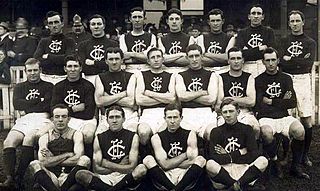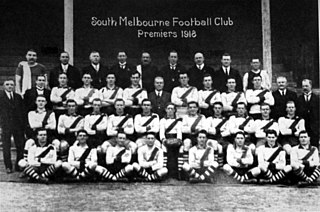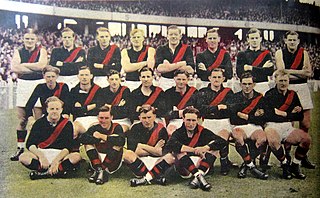
The Geelong Football Club, nicknamed the Geelong Cats, is a professional Australian rules football club based in Geelong, Victoria, Australia. The club competes in the Australian Football League (AFL), the sport's premier competition.

The Fitzroy Football Club is an Australian rules football club currently competing in the Victorian Amateur Football Association (VAFA). Formed in 1883 to represent the inner-Melbourne municipality of Fitzroy, the club was a member of the Victorian Football Association (VFA), before becoming a foundation member of the breakaway Victorian Football League (VFL/AFL) in 1897.

The Victorian Football League (VFL) is the major state-level Australian rules football league in Victoria and, starting from 2021, New South Wales and Queensland. The league evolved from the former Victorian Football Association (VFA), and has been known by its current name since 1996. For historical purposes, the present VFL is sometimes referred to as the VFA/VFL, to distinguish it from the present day Australian Football League, which was known until 1990 as the Victorian Football League and is sometimes referred to as the VFL/AFL.

The 1898 Victorian Football League season was the second season of the elite Australian rules football competition.

The 1902 Victorian Football League season was the sixth season of the elite Australian rules football competition.

The 1905 Victorian Football League season was the ninth season of the elite Australian rules football competition.
Michael Tuck is a seven-time premiership-winning player, Australian rules footballer with the Hawthorn Football Club in the Victorian Football League (VFL) / Australian Football League (AFL), where he was the games record holder until 30 July 2016 when Brent Harvey played his 427th game for North Melbourne Football Club.

Dustin Fletcher is a former professional Australian rules footballer who played his entire 23 season career for the Essendon Football Club in the Australian Football League (AFL). He is widely acknowledged as one of the finest defenders in VFL/AFL history.
Anthony Liberatore is a former Australian rules footballer who represented the Western Bulldogs in the Australian Football League (AFL).
Bruce Abernethy is a former professional Australian rules footballer who played for the North Melbourne Football Club Collingwood Football Club and Adelaide Football Club in the Victorian/Australian Football League (VFL/AFL), and the Port Adelaide Football Club in the South Australian National Football League (SANFL) and is a media personality.

The Australian Football League (AFL) is the pre-eminent and only fully professional men's competition of Australian rules football. Through the AFL Commission, the AFL also serves as the sport's governing body and is responsible for controlling the laws of the game. Originally known as the Victorian Football League (VFL), it was founded in 1896 as a breakaway competition from the Victorian Football Association (VFA), with its inaugural season commencing the following year. The VFL, aiming to become a national competition, began expanding beyond Victoria to other Australian states in the 1980s, and changed its name to the AFL in 1990.

James Podsiadly is a former professional Australian rules football player who played for the Geelong Football Club and the Adelaide Football Club in the Australian Football League (AFL). He was drafted by Geelong as a mature-aged rookie at pick #50 in the 2009 rookie draft and was traded to Adelaide after the 2013 season.

The 1914 Victorian Football League season was the 18th season of the elite Australian rules football competition.

The 1918 Victorian Football League season was the 22nd season of the elite Australian rules football competition.

The 1949 Victorian Football League season was the 53rd season of the elite Australian rules football competition.
The 1981 Victorian Football League season was the 85th season of the elite Australian rules football competition.
The Australian Football League stages the highest-level senior Australian rules football competition in the country. However, since the late 1980s, when the former Victorian Football League expanded interstate to become the modern Australian Football League, there has not been a league-wide reserves competition; and, since 2000, there has been no dedicated reserves competition of any kind. As a result, AFL-listed players who are not selected in their senior teams are made eligible to play in one of the second-tier state leagues: the Victorian Football League, South Australian National Football League and West Australian Football League. The system used to accommodate AFL-listed players within these leagues varies considerably from state to state.

VFL Women's (VFLW) is the major state-level women's Australian rules football league in Victoria. The league initially comprised the six premier division clubs and the top four division 1 clubs from the now-defunct Victorian Women's Football League (VWFL), and has since evolved into what is also the second primary competition for AFL Women's (AFLW) clubs in Victoria. The league often runs concurrently with the Victorian Football League (VFL).
This page is a collection of VFL/AFL premiership and grand final statistics. The Australian Football League (AFL), known as the Victorian Football League (VFL) until 1990, is the elite national competition in men's Australian rules football. Each year, the premiership is awarded to the club that wins the AFL Grand Final. The grand final has been played in all VFL/AFL seasons except for 1897 and 1924, and has been an annual tradition in its current format since 1931.